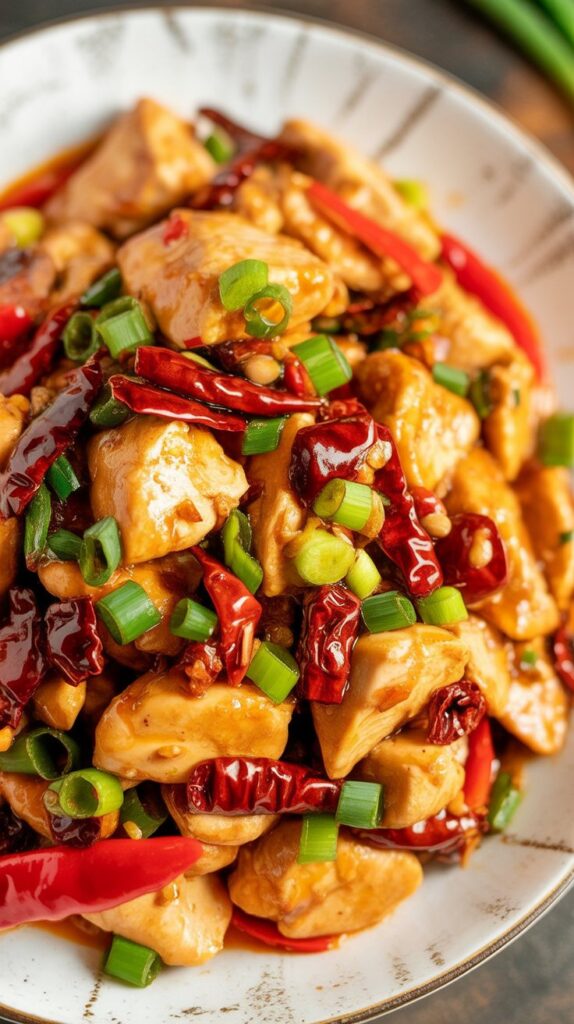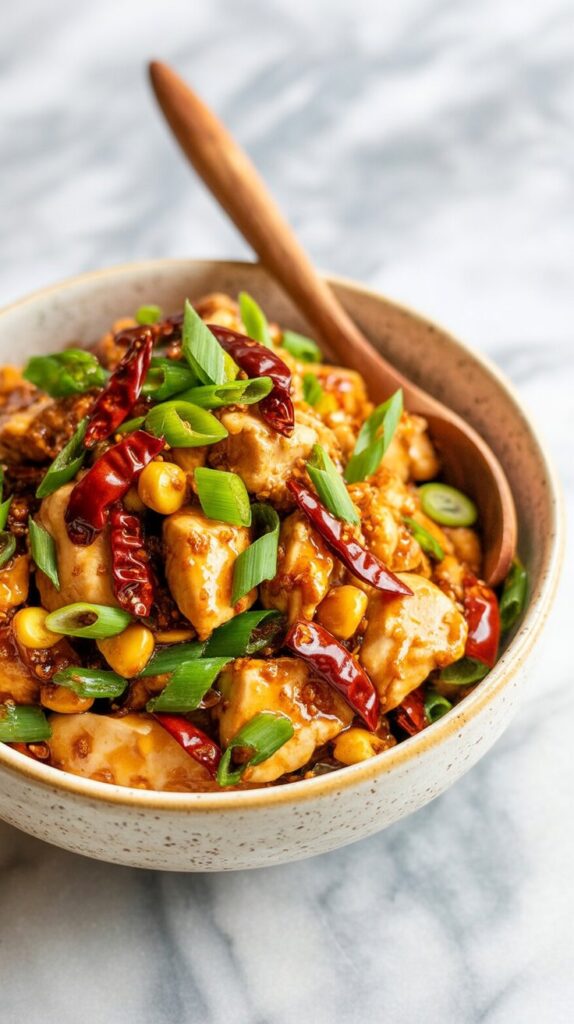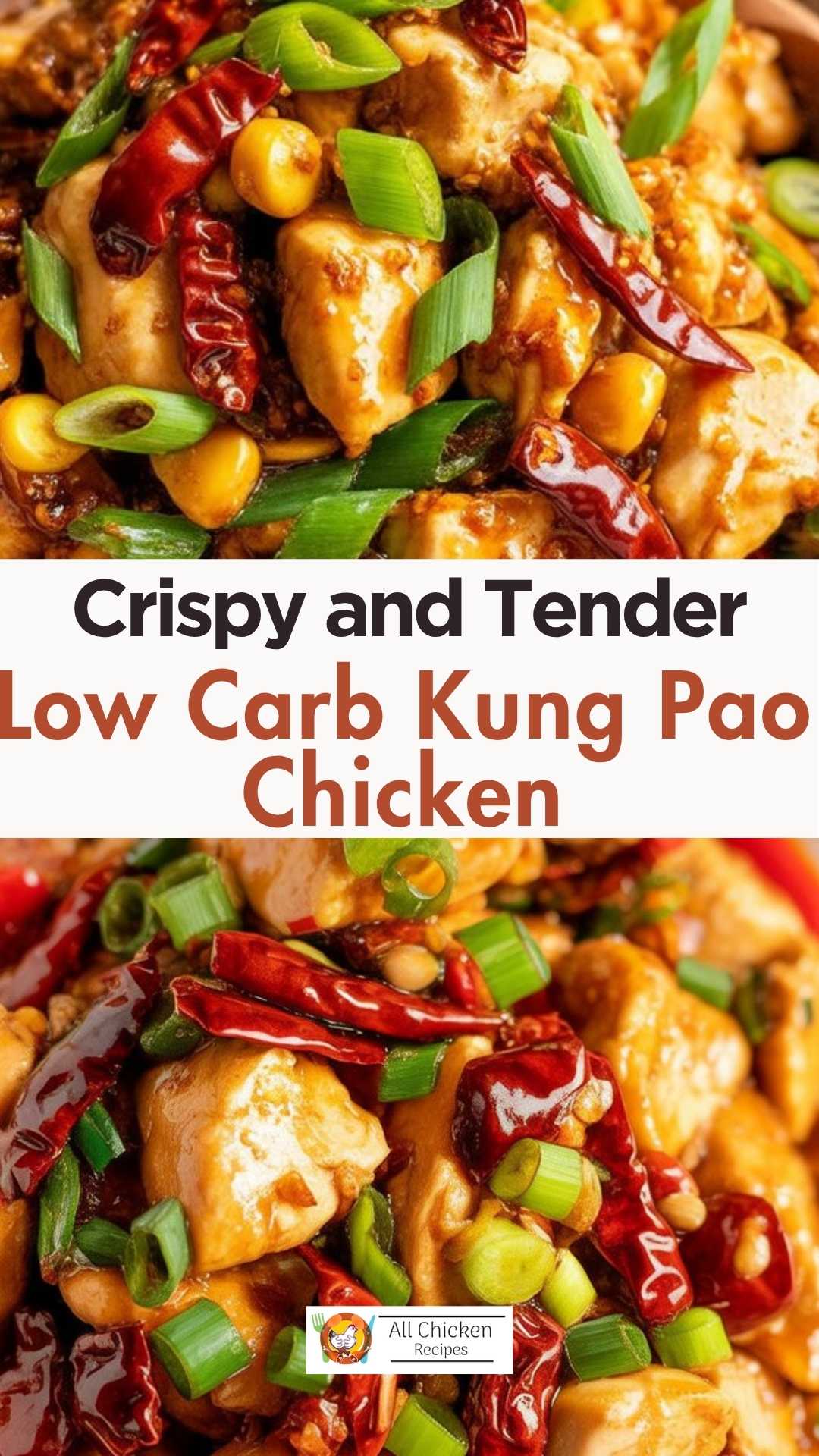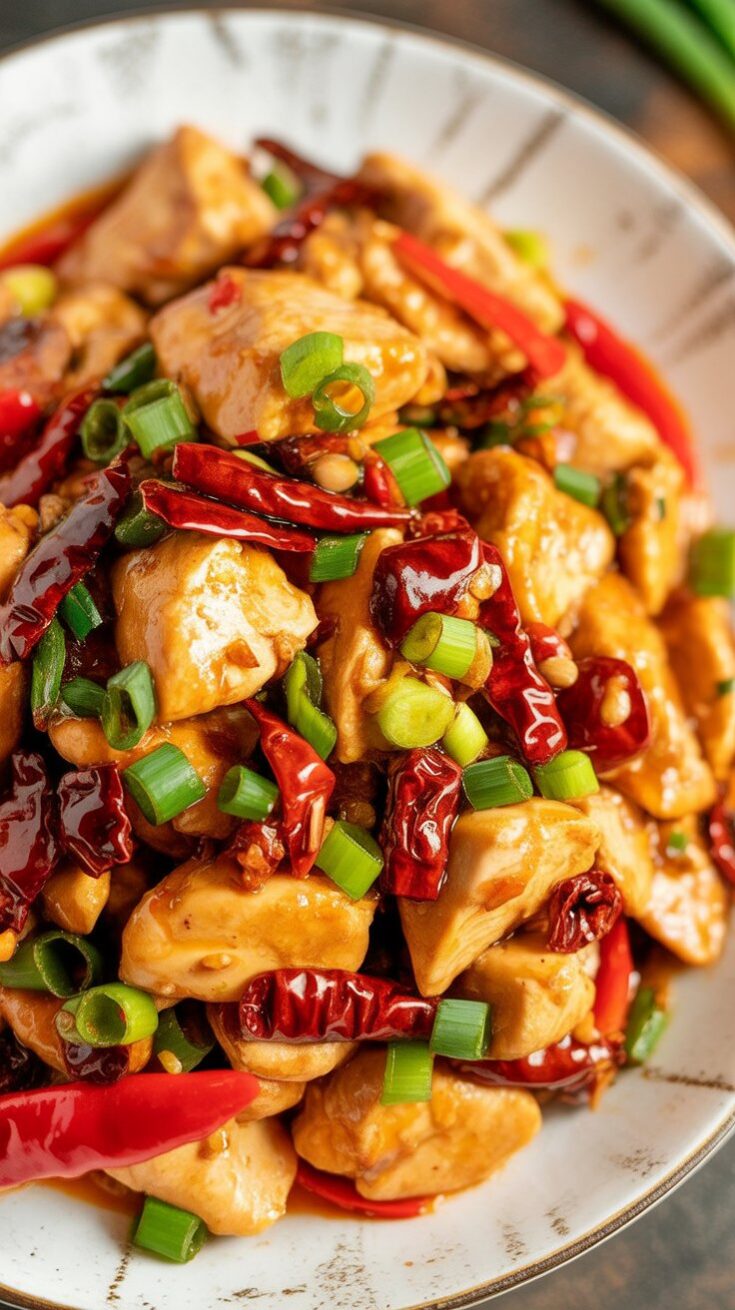If you’ve ever found yourself standing in front of the fridge, torn between ordering takeout or cooking something that’s actually good for you—this is the dish you’ve been waiting for. My version of Kung Pao Chicken keeps all the bold, fiery flavors you love but makes it totally doable for anyone eating Paleo, Whole30, or Keto.

And honestly? This is the kind of meal that makes you feel like a kitchen ninja. It’s full of flavor, quick to make, and tastes like your favorite Chinese takeout—just cleaner, lighter, and way more satisfying.
Why I Keep This Recipe on Repeat
I first made a version of this dish when I was deep in a Whole30 stretch and craving something bold. Everything I loved about Kung Pao was still there—the smoky chilies, that salty-sweet glaze, and the crunch from toasted cashews—but made with better ingredients that didn’t leave me feeling heavy or sluggish afterward.
Now it’s become one of my go-to weeknight stir-fries. Once you try this version, you’ll get why.
So, What Is Kung Pao Chicken?
Traditional Kung Pao Chicken is a Sichuan stir-fry dish made with cubed chicken, peanuts, dried red chilies, and a punchy soy-based sauce. The name comes from a Qing dynasty official, Ding Baozhen, whose title was “Kung Pao”—which basically means this dish has royal approval.
But unlike the heavily sauced, overly sweet versions you might get at the mall food court, real Kung Pao is all about balance. Each bite should be bold but not soggy. A little sweet, a little spicy, and just the right amount of heat that makes you reach for another bite.
In this paleo-friendly twist, I swap a few ingredients while keeping the flavors just as punchy.
Ingredients You’ll Need
Here’s what I use to make this clean and delicious version of Kung Pao Chicken at home. Nothing fancy—just simple pantry staples and a few Asian grocery store gems:
The Chicken Stir-Fry:
- Chicken thighs or breasts – Cut into small cubes. The smaller you go, the better the texture and flavor absorption.
- Cashews or pine nuts – A great swap for traditional peanuts, and they toast up beautifully.
- Garlic, ginger, scallions – The aromatic trifecta. Don’t skip these—they bring life to the dish.
- Chinese dried red chilies – Adds subtle heat and visual flair. I keep them whole so the spice stays manageable.
- Sichuan peppercorns – They give that signature tingling, mouth-numbing effect. You can use them whole or just to infuse oil.
The Sauce:
- Coconut aminos – My go-to swap for soy sauce. Adds depth and sweetness without any gluten or soy.
- Rice vinegar (or apple cider vinegar) – For that sharp little kick.
- Harissa paste – Not traditional, but hear me out—it adds spice, salt, and body to the sauce. A little goes a long way.
- Arrowroot powder – Helps the sauce cling to every bite of chicken in a silky way.

Sauce Talk: Harissa in Kung Pao?
It sounds wild, I know. But harissa works surprisingly well with coconut aminos—it deepens the flavor, adds a touch of heat, and thickens the sauce beautifully. Plus, it gives this dish that extra punch that makes it taste restaurant-level.
If you’re cooking for kids or spice-sensitive folks, feel free to swap in tomato paste for a milder version.
Sichuan Peppercorns: Yes or No?
I grew up watching my grandmother roast Sichuan peppercorns in a dry wok before adding them to her stir-fries, and that smell always takes me back. They’re not spicy like chilies, but they have this lemony zing and that numbing sensation—what we call ma la in Chinese cooking.
Here’s how I use them:
- If I want a milder flavor, I toast them in oil and remove them before cooking the rest.
- If I’m going all-in, I leave them in the dish—just like my grandmother did. They’re a bit bold, but I love the complexity they add.
Those Gorgeous Dried Red Chilies
You’ll often see these whole chilies tossed into Sichuan-style dishes. I use them mainly for aroma and presentation. They aren’t meant to be eaten whole (please don’t!)—they just hang out in the dish to infuse a subtle heat and color.
If you can’t find them, red bell peppers or a few chili flakes will do in a pinch.
How to Make This Paleo Kung Pao Chicken
This dish comes together FAST, so have everything chopped and ready before you fire up the stove.
- Marinate & Prep the Chicken
Cut your chicken into small cubes and toss it with a pinch of salt and a bit of coconut aminos. Let it sit while you prep everything else. - Sear the Chicken
Heat avocado oil in a wok or large pan. Fry the chicken until golden brown and cooked through. Set aside. - Build the Flavor Base
In the same pan, add a little more oil if needed. Sauté garlic, ginger, and scallions with Sichuan peppercorns and dried red chilies. Your kitchen will smell amazing right about now. - Add Chicken Back In
Toss the cooked chicken back into the pan with the aromatics. - Sauce It Up
Pour in the sauce mixture and stir-fry everything until the sauce thickens and coats each piece of chicken. Toss in your toasted cashews and give it a final mix. - Serve Hot
Serve immediately over cauliflower rice or regular rice if you’re not doing Paleo. I usually add steamed broccoli or a quick cucumber salad on the side to round things out.
Tips for the Best Kung Pao at Home
- Prep first, cook fast – This is a high-heat stir-fry. You don’t want to be scrambling for garlic mid-sizzle.
- Don’t crowd the pan – Cook the chicken in batches if needed to keep that beautiful sear.
- Use a neutral oil with a high smoke point – Avocado oil or grapeseed oil works well here.
- Taste the sauce before adding it – Adjust salt, spice, or sweetness based on your personal preference.

Want It Less Spicy?
You’ve got options:
- Skip the Sichuan peppercorns and use a mix of black pepper + lemon zest instead.
- Swap harissa for tomato paste.
- Replace dried chilies with sliced red bell peppers for color without the heat.
It’ll still be incredibly tasty—just a gentler ride.
Low Carb Kung Pao Chicken

This better-for-you version of Kung Pao Chicken is just as addictive as the takeout kind — juicy chicken stir-fried with gingery aromatics, toasted nuts, and a glossy, spicy-sweet sauce that clings to every bite.
Ingredients
For the Chicken:
- 1½ lbs boneless, skinless chicken thighs or breasts, diced into ½-inch pieces
- 1½ tbsp coconut aminos
- ¼ tsp garlic powder
- ¼ tsp onion powder
- ¼ tsp coarse salt
- ½ tsp arrowroot powder
For the Stir-Fry:
- Avocado oil (for cooking)
- Raw pine nuts or cashews (a small handful)
- 3–4 garlic cloves, thinly sliced
- 1 tbsp fresh ginger, finely chopped
- 2–3 scallions, chopped (reserve green parts for garnish
- 5 whole Chinese dried red chilies
- 1–2 tsp whole Sichuan peppercorns (see notes)
- 1 tsp toasted sesame oil (optional)
For the Sauce:
- 2 tbsp coconut aminos
- 1 tsp rice vinegar or apple cider vinegar
- 1 tsp harissa chili paste (or tomato paste for milder heat)
- ¼ tsp arrowroot powder
Instructions
- In a mixing bowl, toss the diced chicken with coconut aminos, garlic powder, onion powder, salt, and arrowroot. Let it marinate in the fridge for 10 to 15 minutes.
- Meanwhile, prep the garlic, ginger, scallions, chilies, and Sichuan peppercorns. Stir together all sauce ingredients in a small bowl until smooth. Set aside the green parts of the scallions for garnish.
- Heat a large skillet or wok over medium-high heat. Once hot, drizzle in about 1 to 1½ tablespoons of avocado oil. Add the marinated chicken in a single layer and cook until golden brown on one side, about 3 minutes. Flip and cook for another 1–2 minutes until fully cooked. Transfer the chicken to a plate.
- In the same pan, add a bit more oil. Toss in the garlic, ginger, white parts of scallions, chilies, and peppercorns. Add a small pinch of salt and stir-fry just until fragrant — about 8 seconds. Be careful not to let the spices burn.
- Return the chicken to the pan, along with the pine nuts. Give the sauce one more stir, then pour it into the skillet. Toss everything quickly until the chicken is coated and glossy. Turn off the heat.
- Finish with a drizzle of toasted sesame oil (if using) and top with the reserved scallion greens. Serve hot.
Notes
- Milder Version: Use red bell pepper instead of dried chilies, tomato paste instead of harissa, and sub Sichuan peppercorn with a mix of black pepper and lemon zest.
- Sichuan Peppercorns: These add a tongue-tingling sensation. If you’re not a fan, sauté them in the oil to infuse the flavor, then remove before continuing.
- Dried Chilies: These are for aroma and appearance — not to be eaten. Leave them whole so the seeds stay inside and the heat stays manageable.
Nutrition Information
Yield
4Serving Size
1Amount Per Serving Calories 492Total Fat 24gSaturated Fat 5gTrans Fat 0gUnsaturated Fat 17gCholesterol 208mgSodium 948mgCarbohydrates 29gFiber 5gSugar 8gProtein 47g
All Chicken Recipes.com, occasionally offers nutritional information for recipes contained on this site. This information is provided as a courtesy and is an estimate only. This information comes from online calculators. Although allchickenrecipes.com attempts to provide accurate nutritional information, these figures are only estimates.
Final Thought
This Paleo Kung Pao Chicken has officially earned a spot in my weeknight dinner rotation. It’s quick, full of flavor, and so satisfying you won’t even miss the takeout menu.
Whether you’re cooking for one, two, or meal-prepping for the week, this dish will deliver every time. And the best part? You’ll feel good about what’s on your plate.
